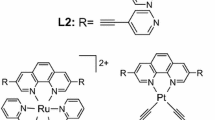Abstract
Novel different substitued polypyridine ligands 4-((4-(1H-imidazo[4,5-f][1,10]phenanthroline-2-yl)phenoxy)methyl)benzaldehyde (BA-PPY), (E)-N-(4-((4-(1H-imidazo[4,5-f][1,10]phenanthroline-2-yl)phenoxy)methyl)benzylidene)-pyrene-4-amine (PR-PPY), (E)-N-(4-((4-(1H-imidazo[4,5-f][1,10] phenanthroline-2-yl)phenoxy)methyl)benzylidene)-1,10-phenanthroline-5amine (FN-PPY), 2-(4-(bromomethyl)phenyl)-1H-imidazo[4,5-f][1,10] phenanthroline (BR-PPY), 2-(4-(azidomethyl)phenyl)-1H-imidazo[4,5-f][1,10]phenanthroline (N3-PPY) and triazole containing polypyridine ligand 3,4-bis[(4-(metoxy)-1,2,3-triazole)1-methylphenyl)-1H-imidazo[4,5-f][1,10]phenanthroline)] benzaldehyde (BA-DIPPY) and Ruthenium(II) complexes were synthesized and characterized. Their photopysical properties were investigated. The complexes RuP(PR-PPY), RuB(PR-PPY, RuP(FN-PPY) and RuB(FN-PPY) exhibited a broad absorption bands at 485, 475, 476, and 453 nm, respectively, assignable to the spin-allowed MLCT (dπ–π*) transition. The emission maxima of the pyrene-appended polypyridine ligand PR-PPY was observed at λems = 616 nm and the phenanthroline-appended polypyridine ligand FN-PPY was observed at λems = 668 nm. And the emission maxima of the complexes RuP(PR-PPY), RuB(PR-PPY), RuP(FN-PPY) and RuB(FN-PPY) were observed at λems = 646, 646, 685 and 685 nm, respectively. As seen in fluorescence spectra, the fluorescence intensities of the ligands are higher than their metal complexes. This is because of quenching effect of Ruthenium(II) metal on chromophore groups.










Similar content being viewed by others
References
Yilmaz Obali A, Ucan HI (2015) J Fluoresc 25:647–655
Kursunlu AN (2015) RSC Adv 5(51):41025–41032
Kursunlu AN (2015) Tetrahedron Lett 56:1873–1877
Devi CS, Satyanarayana S (2012) J Coord Chem 65(3):474–486
Kursunlu AN (2014) RSC Adv 4(88):47690–47696
Xiong Y, Ji L-N (1999) Coord Chem Rev 185–186:711–733
Balzani V, Juris A (2001) Coord Chem Rev 211:97–115
Cheng F, Tang N, Chen J, Wang F, Chen L (2010) Inorg Chem Commun 13:757–761
Chao H, Qiu Z-R, Cai L-R, Zhang H, Li X-Y, K.-S.Wong, Ji L-N (2003) Inorg Chem 42(26):8600–8910
Cheng F, Tang N, Chen J, Chen L, Jia L, Chen G (2010) Inorg Chem Commun 13:258–261
Yilmaz Obali A, Ucan HI (2012) J Fluoresc 22:1357–1370
Zhenga Z-B, Duana Z-M, Zhanga J-X, Wang K-Z (2012) Sensors Actuators B 169:312–319
Ziessel R (2001) Coord Chem Rev 216–217:195–223
Wang X-L, Chen Y-Q, Liu G-C, Zhang J-X, Lin H-Y, Chen B-K (2010) Inorg Chim Acta 363:773–778
Lodeiro C, Limaa JC, Parola AJ, Seixas de Melo JS, Capelo JL, Covelo B, Tamayoa A, Pedras B (2006) Sensors Actuators B 115:276–286
Kursunlu AN, Güler E (2013) Supramol Chem 25(8):512–521
Fleischel O, Wu N, Petitjean A (2010) Chem Commun 46:8454–8456
Zheng RH, Guo HC, Jiang HJ, Xu KH, Liu BB, Sun WL, Shen ZQ (2010) Chin Chem Lett 21:1270–1272
Lenaerts P, Storms A, Mullens J, D’Haen J, Görller-Walrand C, Binnemans K, Driesen K (2005) Chem Mater 17:5194–5201
Ji Z, Huang SD, Guadalupe AR (2000) Inorg Chim Acta 305:127–134
Sullivan BP, Salmon DJ, Meyer TJ (1978) Inorg Chem 17(12):3334–3341
Jing L, Dingmei Z, Xun Z, Zhenjian H, Shu L, Mengfeng L, Jiyan P, Yongcheng L (2011) Mar. Drugs 9:1887–1901
Rose MJ, Patra AK, Alcid EA, Olmstead MM, Mascharak PK (2007) Inorg Chem 46(6):2328–2338
Kumar P, Sain B, Jain SL (2014) J Mater Chem A 2:11246–11253
Rillema DP, Mack KB (1982) Inorg Chem 21:3849–3854
Acknowledgments
We thank the Scientific Research Projects Foundation of Selcuk University (SUBAP) (Konya/TURKEY) for financial support of this work produced from a part of Aslıhan YILMAZ OBALI’s PhD Thesis.
Author information
Authors and Affiliations
Corresponding author
Rights and permissions
About this article
Cite this article
Obali, A.Y., Ucan, H.I. Preparation of Different Substitued Polypyridine Ligands, Ruthenium(II)-Bridged Complexes and Spectoscopıc Studies. J Fluoresc 26, 1685–1697 (2016). https://doi.org/10.1007/s10895-016-1859-3
Received:
Accepted:
Published:
Issue Date:
DOI: https://doi.org/10.1007/s10895-016-1859-3




